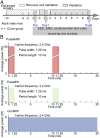Specific electromagnetic radiation in the wireless signal range increases wakefulness in mice
- PMID: 34330835
- PMCID: PMC8346830
- DOI: 10.1073/pnas.2105838118
Specific electromagnetic radiation in the wireless signal range increases wakefulness in mice
Abstract
Electromagnetic radiation (EMR) in the environment has increased sharply in recent decades. The effect of environmental EMR on living organisms remains poorly characterized. Here, we report the impact of wireless-range EMR on the sleep architecture of mouse. Prolonged exposure to 2.4-GHz EMR modulated by 100-Hz square pulses at a nonthermal output level results in markedly increased time of wakefulness in mice. These mice display corresponding decreased time of nonrapid eye movement (NREM) and rapid eye movement (REM). In contrast, prolonged exposure to unmodulated 2.4-GHz EMR at the same time-averaged output level has little impact on mouse sleep. These observations identify alteration of sleep architecture in mice as a specific physiological response to prolonged wireless-range EMR exposure.
Keywords: electromagnetic radiation; mouse model; public health; sleep; wireless signal.
Copyright © 2021 the Author(s). Published by PNAS.
Conflict of interest statement
The authors declare no competing interest.
Figures





References
-
- Pereda D. G., Fernandez Andres M., Pena Valverde I., Gil Abaunza U., Arrinda Sanzberro A., “Time variability of electromagnetic exposure due to Wi Fi networks” in 2019 International Conference on Electromagnetics in Advanced Applications (ICEAA) (IEEE, 2019), pp. 1199–1202.
-
- Alsop T., WLAN connected devices worldwide 2016–2021. https://www.statista.com/statistics/802706/world-wlan-connected-device/. Accessed 29 December 2020.
-
- Kocevska D., et al. ., Sleep characteristics across the lifespan in 1.1 million people from the Netherlands, United Kingdom and United States: A systematic review and meta-analysis. Nat. Hum. Behav. 5, 113–122 (2021). - PubMed
-
- Vander Borght M., Wyns C., Fertility and infertility: Definition and epidemiology. Clin. Biochem. 62, 2–10 (2018). - PubMed
-
- Baxter A. J., Scott K. M., Vos T., Whiteford H. A., Global prevalence of anxiety disorders: A systematic review and meta-regression. Psychol. Med. 43, 897–910 (2013). - PubMed
Publication types
MeSH terms
LinkOut - more resources
Full Text Sources

